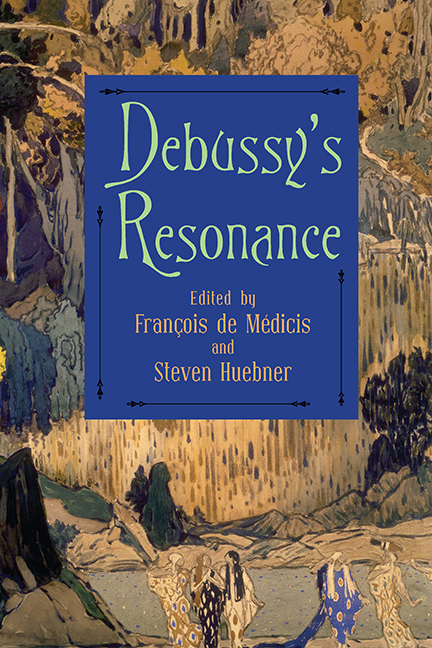Book contents
- Frontmatter
- Contents
- List of Illustrations
- Acknowledgments
- List of Abbreviations
- Introduction
- Part One Historiographical and Editorial Issues
- Part Two Style and Genre
- Part Three History and Hermeneutics
- Part Four Theoretical Issues
- 14 Follow the Leader: Debussy's Contrapuntal Games
- 15 Debussy's Absolute Pitch: Motivic Harmony and Choice of Keys
- 16 Debussy's G♯/A♭ Complex: The Adventures of a Pitch-Class from the Suite bergamasque to the Douze études
- 17 The Games of Jeux
- Part Five Performance and Reception
- List of Contributors
- Index
15 - Debussy's Absolute Pitch: Motivic Harmony and Choice of Keys
from Part Four - Theoretical Issues
Published online by Cambridge University Press: 27 July 2019
- Frontmatter
- Contents
- List of Illustrations
- Acknowledgments
- List of Abbreviations
- Introduction
- Part One Historiographical and Editorial Issues
- Part Two Style and Genre
- Part Three History and Hermeneutics
- Part Four Theoretical Issues
- 14 Follow the Leader: Debussy's Contrapuntal Games
- 15 Debussy's Absolute Pitch: Motivic Harmony and Choice of Keys
- 16 Debussy's G♯/A♭ Complex: The Adventures of a Pitch-Class from the Suite bergamasque to the Douze études
- 17 The Games of Jeux
- Part Five Performance and Reception
- List of Contributors
- Index
Summary
In tonal music, the formal importance of a particular key is often signaled by an indication in the title, e.g., Symphony no. 5 in C minor, op. 67. Beethoven's Fifth is designated “in C minor” even though its second movement is in A-flat major and its finale in an empyrean C major. Primacy of a particular key is of course a structural consideration; but within the individual movement, whether the composer has said so or not, the priority of a single key is usually announced by tonal closure, by ending in the same key as the movement began. But typically there is another announcer as well: the key signature. In the first movement of Beethoven's Third Symphony, the Sinfonia eroica, op. 55, nearly seven hundred measures long and lasting twenty minutes, the key signature never changes, though one may identify as many as twenty-seven actual modulations just between the first measure of the exposition and the beginning of the recapitulation; by contrast, merely as an exercise, one may compare Beethoven's Prelude, op. 39, no. 2, seventy-six measures long, in which there are twenty-four changes of key signature, including twelve just between measures 51 and 62, but this is obviously a special case.
In a work as large as an opera, tonal closure can be demonstrated in the abstract by the first and last tonalities heard in the opera, regardless of division into acts with intermissions in between. Mozart's Magic Flute is one example, with an E-flat-major overture and finale of act 2, and the dreimalige Akkord in the middle (which in any case is a dominant, as it is in the overture), and everyone knows about the Masonic symbolism of three flats in this work. Similarly, Weber's Freischütz and Verdi's Falstaff are, so to speak, C-major operas, as was Beethoven's Fidelio in its first Leonore version. Wagner's Meistersinger certainly has C major as a symbolic unifying tonality with closure, but it also emblematizes the central role of the Master Singers, for C major is their key. Even the Ring of the Nibelungs can be said to have D-flat major as an overarching “Valhalla tonality,” if the first scene of Das Rheingold, beginning in E-flat major and freely modulating, is regarded as a prologue to everything that follows.
- Type
- Chapter
- Information
- Debussy's Resonance , pp. 419 - 434Publisher: Boydell & BrewerPrint publication year: 2018



